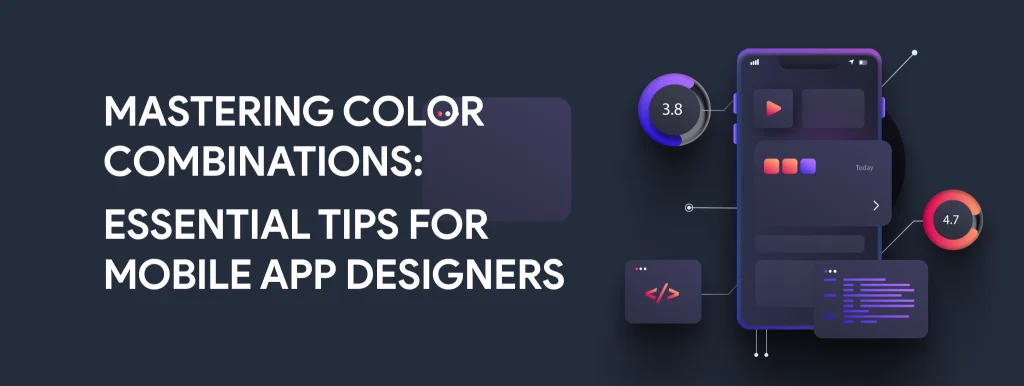Mastering Color Combinations: Essential Tips for Mobile App Designers
2 Aug 23 


How to choose a color palette for an app is one of the most frequently asked topics while developing an app. One of the most crucial aspects of UI/UX design for mobile apps is color. Even with only the correct palette, mobile app designers can improve a mediocre design. Brand identity, prominent designs, color palette generation methods, and user demographics are all considered when choosing color schemes for mobile apps.
A decent consumer experience depends on a solid mobile app development company. This article will provide a complete overview of how to choose the ideal color scheme for mobile applications and what factors to consider while designing the user interface for mobile apps.
Importance of Color in UI/UX Design
As mobile app designers, we think using a bad color scheme is the most straightforward problem. The use of complementary and analogous colors in a color scheme allows for a beautiful design that emphasizes the significance of color. It undoubtedly affects the user’s initial perception. It creates the application’s atmosphere and promotes customer engagement and retention.
In how we interact with visual components, color plays a significant role for mobile app designers. 92% of respondents, according to Xerox Corporation and International Communications research, think color creates images of amazing quality. 90% believe that color draws in new customers. In the opinion of 83%, color enhances the success of themes. 81% believe that their color offers them an advantage over rivals.
Additionally, 76% think using color helps their company look bigger to customers. These four colors are the ones that people like, according to KISS metrics like in blue, Green, Red, and Purple. Over 75 percent of the populace is drawn to them. They are, of course, the ideal color for mobile apps.
The potential of colors to affect our emotions and alter our behavior is unique. Color choices vary across individuals and between different ages. Consider the message and atmosphere you hope to communicate when selecting colors for your upcoming mobile app development. Choosing the appropriate colors is crucial since the wrong ones may rapidly turn users away.
Colour Palette Tips & Practises
Creating a color palette takes more than simply paying attention to technical aspects. The “design eye” must occasionally be trusted by the mobile app designers. Knowledge is also needed for this. Below are some tips and recommendations for mobile app designers.
1. Keep in Mind Cultural Shifts
Colors hold a lot of cultural significance for mobile app designers. For instance, there are significant disparities between Brazilian and Japanese colors. The app’s target audience should be considered before beginning the design. A “cultureless” design style should be chosen for designs that will be widely utilized internationally, as is to be desired.
2. Remember to Use Light & Dark Modes
Designing mobile apps with a system-specific color mode is now a must. Broadly, a light mode approach is preferable if a single color mode is intended. However, consumers are adjusting to dark mode as an option. Making a dark color palette for the designs can be helpful. In dark mode, contrast is the most crucial factor to consider. Dark mode contrast is more challenging to see than bright mode contrast. A dark mode that is inadequately developed affects reading. It also impedes accessibility inadvertently.
Note: You might want to think again before using pure black and white as contrast.
3. A Lot of Colors Distract
Management becomes difficult when more colors are chosen. When using numerous colors, practice is crucial for mobile app designers. The drawback that makes it challenging for the consumer to utilize the interface’s functions to perform actions is typically using several colors. As a recommendation, if the app’s peculiarities require several colors, you may combine prominent colors with delicate hues like neutral and pastel.
As a result, even if more colors are employed, there are fewer prominent colors. It offers contrast and does not strain the eyes. When looking at samples of contemporary design, you can notice how lovely neutral, pastel, and shaded tones produce balance. Consider pairing pastel or neutral tones with shaded tones in your upcoming designs rather than overstocked colors.
4. Use Plugins & Tool Functionality
The equipment utilized by mobile app designers in the mobile design process is rather sophisticated. These tools include Figma, Sketch, Adobe XD, and InVision. The community for the tools creates plugins to make tasks simpler. It may produce nearly ideal color tones since design considerations are considered while designing plugins. A Google search will provide several color palette generators.
5. Select an Appropriate Color Range for Digital Projects
Using different color gamuts when working with printed and digital items is preferable. The options are RGB and CMYK. In digital, RGB is preferred because it stands for red, green, and blue. All colors on a digital display are created by combining these three colors in a specific ratio. When they are all mixed, white results. Cyan, Magenta, Yellow, and Key (CMYK) are the colors it stands for.
The written word is used with it. These colors are not preferred for mobile app designers since they are not exclusively generated from digital displays. Additional technologies and subcategories exist, including RGB and CMYK. P3, Pantone, Adobe RGB, and many other examples come to mind. But the most often used colors ought to be chosen.
The colors you see are not visible to other users since their screens differ. Yes, everyone can see the color their cell phones’ screens provide. The equipment used by each screen causes some variations in color tones, even though there are global color standards. Using digital codes like HEX, HSL, and HSB is another problem. Do not mix this selection with the color range; you can choose any.
How to choose the color scheme for your application?
Many people approach the development teams unsure of the exact appearance and features they want to include in their upcoming applications. And that is entirely OK because professionals like business analysts and designers may assist you in shaping your concept.
The designer will focus on the appearance of your app while the Business Analyst does market research to determine what may become a tremendous competitive edge for you. Additionally, the designer will adhere to a few essential principles outlined below when choosing the appropriate color palette.
1. Investigate Color Psychology
It is well known that colors have an emotional impact. You must thus consider your company’s personality, idea, and the outcome you wish to accomplish when selecting colors for your app. Your solution’s design needs to deliver a specific message and atmosphere. And for years, color psychology has been studying this subject. While fashions change over time, specific fundamental ideas endure.
Colors significantly impact how your app users behave, may highlight critical elements of your brand, and can entice users to make in-app purchases. All colors have excellent and bad meanings, so this must be considered. Red, for instance, might signify strength, security, or speed. In addition, it connotes danger, hostility, and disobedience. Consider the color blue, representing intellect, trust, and composure. However, its negative meaning suggests bitterness and depression.
2. Be Mindful of the Viewers
Both the color itself and a few personality-related variables influence color reactions. For instance, the color scheme of an application may elicit diverse responses from users with various genders, ages, or cultural experiences. Adults would instead choose more restrained, classic options than children, who favor brighter color schemes.
Therefore, identify your app’s target market before selecting a color scheme. Pay attention to more neutral colors with complementing highlights if the remedy is intended for commercial use and must function with a serious clientele. If you create a relaxing solution geared at students and those between the ages of 35 and 40, you may incorporate more vibrant colors.
3. Be Mindful of the UI Guidelines
The expert must keep the UI in mind if a solution is being created. Mobile app designers can build visually complete navigation and design by using colors, images, and visual structures. He also influences customer focus and can direct it in the right direction. Additionally, the designers adhere to a set of UI standards, which include the following:
- Since specific colors work seamlessly together and others are not designed to be blended, the designer must carefully choose how to pair the colors. The color wheel also facilitates this.
- It’s essential to achieve color consistency and aim for simplicity by avoiding highly colorful choices.
- Various colors should be used for the components that perform multiple roles.
- Try to avoid giving interactive and non-interactive parts the same color.
- To make the writing legible against light backgrounds, use dark colors.
- Utilize bright colors for highlights and maintain background light.
4. The Colors Present & Contrast in the Number
It’s important to keep things straightforward and use no more than four colors while developing your app. Why do you require a lot of them? The primary color will be one, the content will be one, and the components will be accented with two colors (which may be shades).The most significant color on this list is the primary color because it will be closely linked to your business. And other hues need to harmonize with it and give off a polished, completed appearance.
Text colors should be attractive to the eye to ensure the app’s customers can readily understand everything. The components, such as buttons and display notifications, must stick out and be noticeable. It is preferable to employ intermediate contrast to bring consumers’ focus to items that require significant contrast, such as distinct buttons for action, operational faults, etc. Observe how the background and text colors contrast as well. An excessive contrast between them may render the text impossible to read.
Wrapping Up
As you can surely guess, the layout is your app’s ultimate and most important finishing touch. It enhances the appeal and visibility of your brand, like the cherry on top of a dessert. Following the fundamental color guidelines is essential to producing a pleasing design.
The choice of colors, as well as the colors and tones, is crucial. Your answer won’t seem reasonable if you go overboard. And you certainly don’t require that. But don’t worry. You don’t need to delve too deeply into color theory. Highly competent mobile app designers that have long since accomplished the production of color schemes would be pleased to construct your app’s layout to help it stand out from the competition.
- Agentic AI1
- Android Development3
- Artificial Intelligence34
- Classified App3
- Custom App Development5
- Digital Transformation12
- Doctor Appointment Booking App14
- Dropshipping1
- Ecommerce Apps40
- Education Apps2
- Fintech-Apps37
- Fitness App4
- Flutter4
- Flutter Apps20
- Food Delivery App5
- Grocery App Development1
- Grocery Apps3
- Health Care10
- IoT2
- Loyalty Programs9
- Matrimony Apps1
- Microsoft1
- Mobile App Maintenance2
- Mobile Apps129
- Product Engineering6
- Progressive Web Apps1
- React Native Apps2
- Saas Application2
- Shopify9
- Software Development3
- Taxi Booking Apps7
- Truck Booking App5
- UI UX Design8
- Uncategorized6
- Web App Development1



















Comments